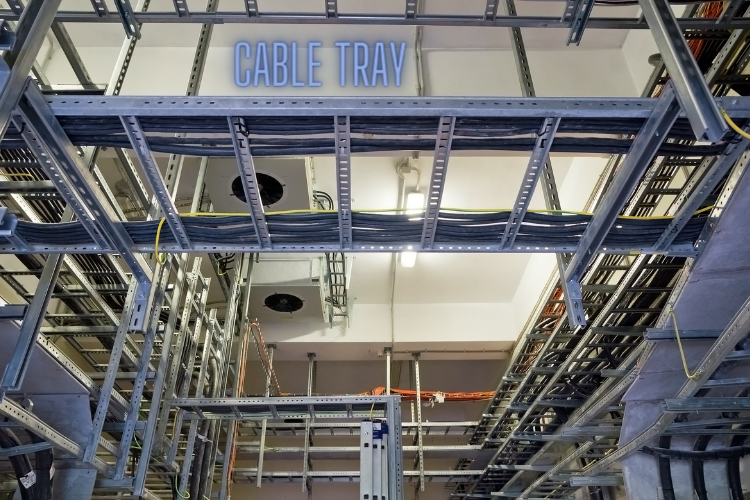How to Choose the Right Cable Management Tray
The components of support systems for power and communication cables and wires are called cable trays. Each power and communication line is supported and safeguarded by a cable receptacle system, which also makes it easier to upgrade, expand, reconfigure, or relocate networks.
What are the main types of cable trays?
If you’re wondering how many kinds of cable trays there are, the primary categories include:
- Cable trays on ladders.
- Cable trays with solid bottoms.
- Cable trays with wire mesh.
- Trays for cables with holes.
Perforated Cable Tray
Perforated Cable Trays are made of a single component and have a solid or ventilated bottom. they are mainly utilized with control and power connections. Depending on the needs of the client and the site conditions, they are available in Light, Medium, and Heavy Duty. Features produced with premium raw materials Strength for Industry High durability Strong Design Simple to install accessible for applications in light, medium, and heavy-duty. There is a large selection of Perforated Cable Tray Accessories, Covers, and Fixings. The on-site integration and safety are excellent.
We are a Supplier, and Exporter of Cable Trays, Ladder Type Cable Trays, Perforated Type Cable Trays, Hot Dip Galvanized Cable Trays
Insulated electric cables used for power distribution and communication are supported by a cable tray system. In commercial and industrial construction, cable trays are frequently used for cable management as an alternative to open wiring or electrical conduit systems. Since new wires may be placed by placing them in the tray rather than pulling them through a pipe, they are especially helpful when changes to a wiring system are anticipated.
The leading supplier of both ladder-style and perforated cable trays on the market is iEngineering. We supply Cable Trays that are offered in a variety of dimensions, including length, width, height, and thickness, to meet exact customer needs. They are made to be durable in long-span applications. Additionally, they come in a variety of construction materials like steel, aluminum, and aluminum steel. Customers can choose from Painted, Powder Coated, Pre-galvanized, and Hot Dip Galvanized kinds of material finish for Cable Trays constructed of steel. In addition, we provide Hot Dip Galvanized Cable Trays in accordance with IS 4759 and 2629 Standards. Along with providing all necessary accessories, we also offer inner and outside bends, reducers, and tees.
iEngineering offers adaptable Support Systems that are affordable, completely adjustable, and reusable to go along with its Cable Tray product line. They are simple to install and don’t require welding or drilling. These work best in multipurpose electrical, instrumentation, and mechanical system applications. Insulated electric cables used for power distribution and communication are supported by a cable tray system. In commercial and industrial construction, cable trays are frequently used for cable management as an alternative to open wiring or electrical conduit systems. Since new wires may be placed by placing them in the tray rather than pulling them through a pipe, they are especially helpful when changes to a wiring system are anticipated.
Advantages Of Cable Tray
- Cost Saving
- Design cost Savings
- Installation cost and timesaving
- Maintenance Savings
- Space Savings
Standards Available
| FINISH | SPECIFICATION | RECOMMENDED USE |
| Painted | As per Specifications | Indoor |
| Powder Coated | As per Specifications | Indoor |
| Pre-Galvanized | As per Specifications | Indoor |
| Hot Dip Galvanized | As per IS 4759, 2629, 2633 | Indoor / Outdoor |
| MATERIAL SPECIFICATIONS | ||
| STEEL- MS 1079 (O) with 1 mm, 1.2 mm, 1.4 mm, 1.6 mm, 2.0 mm, 2.5 mm, 3.0 mm, 4.0 mm thickness. | ||
How to select a suitable cable tray?
Calculated Cable Tray Width according to the formula:
Calculation=No. of Cable Layers X No. of Cable Tray Run X Cables’ Width.
The calculated cable tray width is 1X1X493 or 493 mm. examining the cable tray’s depth.
Actual cable tray depth is determined by the number of layers times the maximum cable diameter.
Application
It helps and protects each electricity and sign cable and enables upgrading, expanding, reconfiguring, or moving networks.
- High Voltage Power Lines.
- Power Distribution Cables
- Telecommunication cables
- Control cables
- Fibre Optical Cables
- To prevent electrical and fire damage to cables, use a cable tray.
Features
They have strong facet rail safety that permits the unfastened float of air through the machine, fashionable width of those trays is 6 to twenty-five inches, intensity is three to six inches, and lengths are 10 to twelve toes throughout the installation.
- Less expensive as compared to conduit system
- The extra chance of modification, expansion, and accommodation for future business.
- Good cable management system avoids accidents and thus gives safety Flexibility for of Installation Indoor
Cable Tray: Safety Precautions and Maintenance
Wiring inside cable trays has the potential to result in arc-flash explosion events, electric shock, and fires if improperly planned and installed. As a designed component of a cable management system, cable trays can be used to support, route, shield, and provide a path for cable systems. Power, low voltage, and cable trays can all be used together.
For more information and inquiries feel free to contact: kirti@iengaust.com.au & shila@iengaust.com.au




